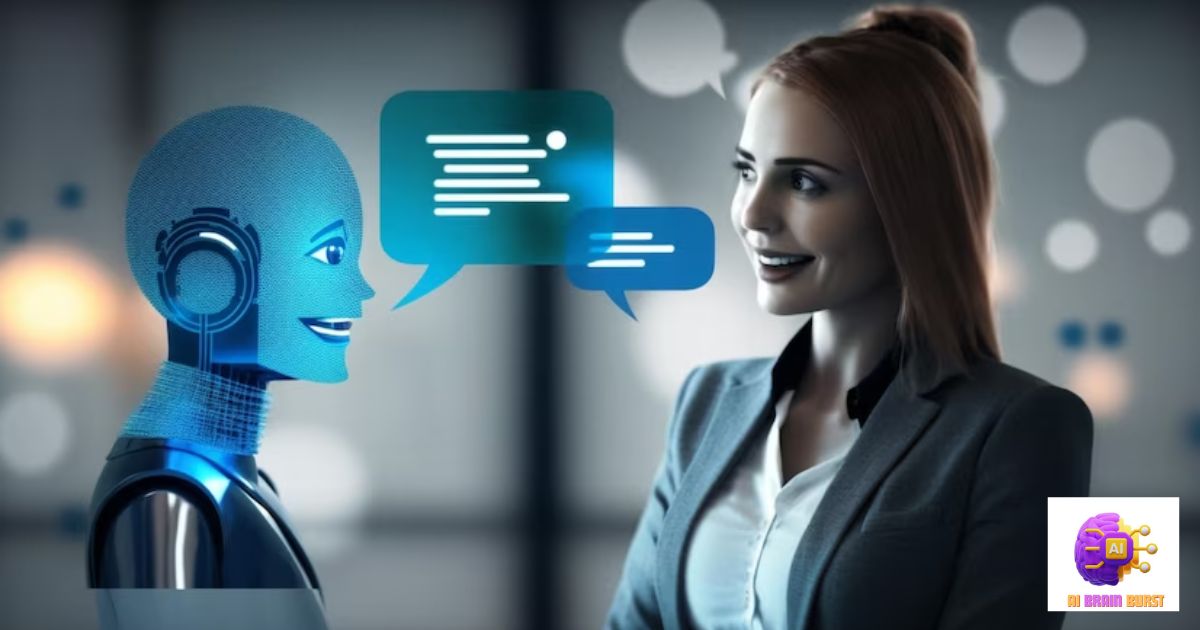In a world where technology is advancing at an unprecedented pace, it’s becoming increasingly difficult to discern whether we’re conversing with a human or an artificial intelligence (AI). The boundaries between human and machine communication are blurring, raising questions about authenticity, trust, and the future of interaction. Let’s delve into this intriguing phenomenon and explore the nuances of distinguishing between AI and human interactions.
Imagine chatting with a customer service representative online, seeking advice or assistance. You pose your query, receive a prompt response filled with empathy and understanding. But here’s the twist – was that response crafted by a real person or a sophisticated AI algorithm? The lines are becoming so indistinct that it’s becoming a challenge to tell the difference. Let’s unravel this mystery together.
The Rise of AI in Communication
Artificial intelligence has rapidly permeated various aspects of our lives, including communication. From chatbots to virtual assistants, AI-driven systems are becoming ubiquitous in facilitating interactions between individuals and businesses. These highly advanced systems, designed to comprehend natural language, analyze data, and generate responses that closely mimic human conversation, have proven to be indispensable in modern society. It’s important, however, to be mindful of the evolving landscape and potential challenges. Strategies such as “Avoid Ai Detection” may be crucial in navigating and optimizing interactions within this dynamic AI-driven environment.
Chatbots: The Frontline of AI Communication
Chatbots are perhaps the most visible manifestation of AI in communication. These computer programs simulate conversation with users, providing instant responses to inquiries or performing tasks based on predefined algorithms. Whether it’s resolving customer queries, scheduling appointments, or ordering food, chatbots are revolutionizing customer service and support operations across industries.
Virtual Assistants: Your Personal AI Companion
Virtual assistants like Siri, Alexa, and Google Assistant have become integral parts of our daily lives. These AI-driven entities not only respond to voice commands but also engage in contextual conversations, offering personalized assistance and recommendations. Whether it’s setting reminders, playing music, or providing weather updates, virtual assistants seamlessly integrate into our routines, blurring the lines between human and AI interaction.
AI-Powered Social Media and Content Creation
AI algorithms are also reshaping how content is generated and disseminated across social media platforms. From personalized recommendations to automated content creation, these algorithms analyze user behavior and preferences to deliver tailored experiences. Whether it’s generating captions for images or suggesting articles to read, AI is playing an increasingly prominent role in shaping online interactions and content consumption.
Navigating the Uncertainty: Strategies for Identifying AI
As AI becomes more sophisticated, distinguishing between AI and human communication poses a considerable challenge. However, several strategies can help discern the subtle differences and navigate this evolving landscape effectively.
Contextual Understanding and Complexity
One key aspect to consider is the depth of conversation and contextual understanding. While AI can provide generic responses based on predefined patterns, human interactions often involve nuances, emotions, and a deeper comprehension of context. Paying attention to the complexity of responses and the ability to navigate unstructured dialogue can offer insights into whether you’re engaging with AI or a human.
Emotional Intelligence and Empathy
Emotional intelligence and empathy are quintessentially human traits that are challenging for AI to replicate authentically. While AI algorithms can simulate empathy to some extent, genuine emotional responses often involve intuition, empathy, and understanding nuances in human behavior. Observing the emotional depth and sensitivity in responses can provide clues about the authenticity of the interaction.
Linguistic Patterns and Behavioral Cues
Analyzing linguistic patterns and behavioral cues can also aid in identifying AI-driven communication. Humans exhibit idiosyncrasies, colloquialisms, and linguistic nuances that may be absent or replicated differently by AI systems. Paying attention to language usage, grammar, and conversational flow can help discern whether you’re conversing with a human or an AI entity.
Human Or Not

1. Emotional Depth: Human communication often exhibits genuine emotional responses, including empathy, humor, and understanding, whereas AI interactions may lack depth and authenticity in emotional expression.
2. Contextual Understanding: Humans possess the ability to grasp subtle nuances and contextual cues in conversation, adapting their responses accordingly, while AI systems may struggle to comprehend complex contexts beyond predefined parameters.
3. Linguistic Nuances: Pay attention to linguistic patterns, idiomatic expressions, and colloquialisms, as humans tend to use language in unique ways that may be challenging for AI algorithms to replicate accurately.
4. Empathetic Responses: Genuine empathy involves intuition, understanding, and the ability to resonate with others’ emotions, qualities that are inherently human and can be challenging for AI to emulate convincingly.
5. Conversation Depth: Human interactions often delve into deeper topics, exploring emotions, beliefs, and personal experiences, while AI interactions typically remain superficial, focusing on providing solutions or information within predetermined boundaries.
6. Behavioral Cues: Observing non-verbal cues, such as tone of voice, body language, and facial expressions, can provide valuable insights into whether you’re conversing with a human or an AI entity, as AI lacks physical presence and non-verbal communication abilities.
7. Intuition and Creativity: Humans possess intuition, creativity, and the ability to think outside the box, traits that often manifest in spontaneous and imaginative responses, whereas AI interactions tend to follow predefined scripts or algorithms without deviation.
Human Or Ai
Determining whether you’re talking to a human or an AI can be tricky. Humans show emotions like empathy, while AI may just pretend. Humans understand context and use slang, but AI can struggle with these subtleties. When talking to a human, conversations can be deep and varied, but AI often sticks to programmed responses. Humans also give off non-verbal cues, like tone and body language, which AI can’t do. Humans are creative and spontaneous, while AI follows set rules.
So, if you’re unsure if you’re talking to a human or AI, look for emotional depth, nuanced language, and non-verbal cues. If the conversation feels shallow or scripted, it might be AI. But if it’s rich, varied, and full of human quirks, chances are you’re chatting with a real person.
Ai Or Human Test
Determining whether you’re chatting with an AI or a human can be tricky. Look for emotional depth and empathy in responses – humans often show genuine emotions, while AI might seem scripted. Pay attention to language use and context too, as humans tend to be more nuanced and adaptable in conversation.
Observing non-verbal cues like tone of voice and body language can also provide clues. Humans express themselves physically, while AI lacks this ability. Remember, humans can be creative and spontaneous in their responses, whereas AI typically follows predefined patterns. Keep these factors in mind when trying to figure out if you’re interacting with AI or a fellow human.
Human Or Ai Game

In the “Human or AI” game, players try to guess whether they are interacting with a real person or an artificial intelligence. It’s like a fun detective challenge, where you analyze the responses and clues to make your guess. Players pay attention to emotions, language, and how the conversation flows to determine if it’s a human behind the screen or a cleverly programmed AI. It’s a fascinating way to explore the capabilities of AI technology while also honing your intuition and observation skills.
As you play the game, you’ll find yourself questioning what it means to communicate authentically and how technology is reshaping our interactions. Whether you’re chatting with a witty AI chatbot or engaging in a heartfelt conversation with a real human, the “Human or AI” game offers a glimpse into the evolving landscape of communication in the digital age.
Human Or Not Unblocked
Are you wondering if you’re chatting with a real person or a clever robot? That’s the dilemma of “Human Or Not Unblocked.” It’s all about figuring out if the messages you’re getting are from a genuine human being or an advanced artificial intelligence. With this game, you’ll learn to spot the subtle clues that reveal whether you’re talking to a person with real emotions and thoughts or an AI programmed to respond in a certain way.
Can You Still Play Human Or Not
| Aspect | Human Communication | AI Communication |
| Emotional Depth | Demonstrates genuine emotions and empathy. | May simulate emotions but lacks genuine depth. |
| Contextual Understanding | Grasps subtle nuances and adapts responses. | Relies on predefined parameters, struggles with complex contexts. |
| Linguistic Nuances | Utilizes idiomatic expressions and colloquialisms. | May struggle with nuanced language usage. |
| Empathetic Responses | Displays genuine empathy and understanding. | May mimic empathy but lacks genuine emotional resonance. |
| Conversation Depth | Engages in deep, multifaceted discussions. | Tends to stick to predefined topics or responses. |
| Behavioral Cues | Exhibits non-verbal cues such as tone and body language. | Lacks physical presence and non-verbal communication abilities. |
| Intuition and Creativity | Demonstrates spontaneity and creative thinking. | Follows predetermined scripts or algorithms. |
This table provides a structured comparison between human and AI communication across various dimensions, aiding in discerning the nature of the interaction.
Human Or Not Alternative
Determining whether you’re chatting with a human or an AI can be tricky. Humans tend to show real emotions like happiness or sadness, while AI might seem a bit too perfect in its responses. Also, humans understand jokes and slang, but AI sometimes struggles with these informal language cues. On the other hand, AI is really good at sticking to the topic and providing quick answers, while humans might go off on tangents or take longer to respond.
So, if the conversation feels very emotional or includes lots of jokes and slang, you’re probably talking to a human. But if the answers are super quick and always on point, it might be an AI doing the talking.
Human Or Not Ai
In today’s digital age, it can be tricky to tell whether you’re chatting with a human or an artificial intelligence (AI). Humans often express genuine emotions and understanding, while AI responses might feel scripted and lack depth. Paying attention to subtle cues like language nuances and empathy levels can help distinguish between the two. However, AI is getting smarter, mimicking human-like responses more convincingly than ever before.
FAQ,s
How do you tell if you are talking to AI?
You can tell if you’re talking to AI by observing if the responses feel scripted or lack genuine emotional depth.
Can you talk to a AI?
Yes, you can talk to an AI through various platforms and applications designed for communication with artificial intelligence systems.
Can AI fall in love?
AI cannot genuinely experience emotions like humans do, including love.
Can AI talk like humans?
Yes, AI can talk like humans, thanks to advanced natural language processing algorithms and machine learning techniques.
Conclusion
In conclusion, the blurred lines between human and AI communication highlight the remarkable advancements in technology. While AI can emulate human-like responses and engage in conversation, it still lacks the depth of genuine human interaction. Despite this, the integration of AI into various aspects of communication is inevitable, offering convenience and efficiency in many areas.
However, as we embrace these technological innovations, it’s essential to preserve the authenticity and empathy that define human connection. By recognizing the strengths and limitations of both AI and human communication, we can navigate this evolving landscape with wisdom and discernment, fostering meaningful connections that transcend the boundaries of technology.








